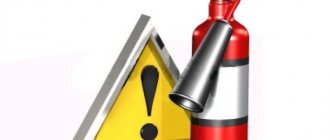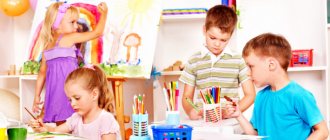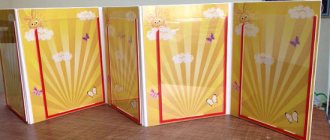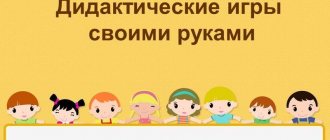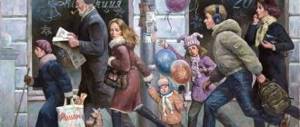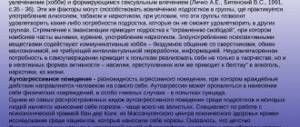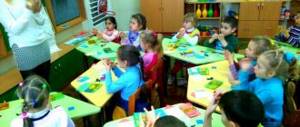Most children love to play with water: in the bath and at the table, in the pool and while walking. Depending on the desires and needs of the child, games with water can be calm, active, or with a plot. With the help of an adult and a properly organized environment, these activities become not only fun, but also extremely useful. They develop fine motor skills, coordination of movements, and relieve emotional stress. Experiments with water allow you to introduce your baby to the world around him, develop thinking and curiosity. In this article we will tell you what simple exercises and experiments with water can be done at home.
Water games for kids
To play with water, you may need containers of various sizes, spoons, ladles, sieves, funnels, water mills, whisks, pipettes, sponges and rags, a tray and other devices. Here are some fun water play ideas that kids are sure to love.
- “Wring out the sponge.” For this game you will need two basins (or deep bowls) and, of course, a sponge. Fill one of the containers with water and leave the other empty. Using a sponge, the baby must pour water from one basin to another.
- "Catch a fish." Place non-sinking objects (for example, small rubber toys, corks, balls, beads) in a bowl of water and invite your child to “catch the fish” using a sieve. Prepare a bowl or bucket where the child will put his catch.
- Pouring liquid from one jug to another is not an easy task for kids. This exercise allows you to develop coordination of movements, eye, and concentration.
- “Pour water into the glasses.” Prepare glasses and other containers of various sizes and shapes, and then use a felt-tip pen or adhesive tape to mark on them the level to which your baby needs to fill them. To make it more interesting for the child, the water can be colored.
To avoid getting the table wet while practicing with water, use a tray as well as a sponge. By cleaning up spilled water, your baby will learn to be independent and neat.
- "Pour through the funnel" . Children love to use various devices in games that they rarely encounter in real life. One of these interesting things is an ordinary funnel.
- "Whip the foam" . Add a little liquid soap to the water and show your child how to use a whisk to whip up fluffy foam.
- "Big Wash" . A basin of water and a few doll dresses or just rags is all that is needed to keep the baby busy for a long time. You can also stretch a rope (for example, between two chairs) and use clothespins to hang toy clothes to dry.
- "Car wash" . To teach your baby to take care of his things, play car wash with him. The baby will be able to wash rubber and plastic toys independently in a soapy solution, and then rinse under running water.
- "Glacial period". Place small toys in a small bowl (or silicone mold), fill them with water, and then freeze them. To easily remove ice from a bowl, pour boiling water over it. The child will feel like a real rescuer, freeing toys from ice using various tools.
Simple experiments with water for preschoolers
Preschool children are natural researchers. Experiences and experiments introduce children to the properties of water, expand their understanding of the world around them, and develop logic and attention.
- Together with your child, determine the basic properties of water:
- Water has no color. Pour plain water into one glass and milk into the other. Then put some objects into the glasses. Milk has color, so objects will not be visible, and it is impossible to hide in clear water.
- Water has no smell. Invite your baby to compare how different liquids smell (water, juice, sunflower oil, etc.).
- Water has no taste. In the same way as in the previous experiment, compare the taste of several drinks with your child.
- Water has no form. By pouring the same amount of water into different vessels (glass, plate, vase), the baby will understand that the liquid does not have a constant shape.
- Water temperature may vary. Invite your child to compare how he feels when touching cold and hot water.
- Ice and steam are also water. Together with your child, watch how steam comes out of a boiling kettle, how the ice melts, how the water freezes in the refrigerator.
- "Drowning - not drowning . Using objects made of various materials (wood, metal, paper, rubber, plastic), you can check which ones will sink and which ones will not.
- “What protects you from the rain?” . Imagine a situation with your child that you are caught in the rain, but you don’t have an umbrella. But there are other items: a plastic bag, a piece of fabric, foil, paper, cardboard. By slowly pouring water over each material, your child will be able to draw conclusions about what gets wet and what repels water.
- "Blooming Flower" Cut out several flowers with oblong petals from colored paper. Then bend them or twist them with a pencil towards the center. If you throw flowers into water, the buds will soon open, as the wet paper becomes heavier. Using this experiment, you can show your child that plants need water to live.
- "Ships made of ice floes." Pour water into ice trays and place a toothpick or small piece of cocktail straw into each tray. After the ice floes are ready, attach paper sails to them and feel free to set sail. The child can blow on the sails to make the ships move. This experiment will introduce your child to the properties of ice and air.
- Lava lamp. For the experiment you will need a small glass jar, vegetable oil, water, food coloring, and salt. The container must be filled 2/3 with water and 1/3 with oil. Point out to the child that oil is lighter than water, so it does not sink or mix with water. Then you need to add a little food coloring and a spoonful of salt to the jar. Salt crystals cause the oil to sink to the bottom, and after the salt dissolves, it rises to the surface. Thanks to this, you can observe the bizarre movement of oil bubbles in the water.
Try to organize the experience in such a way that the child takes an active part in it. If your child has a desire, let him come up with his own experiment and help him implement it.
- “Mixing paint.” This experiment will allow you to explore the color palette and bring a lot of positive emotions to your baby. Using gouache, color the water in several glasses, and then invite your child to mix several colors and see what happens.
- "Water runs along the paths." For the experiment you will need three clear glasses, food coloring and two napkins (gauze bandages). Pour water into two glasses and add food coloring to it (for example, yellow in one glass, red in another), and leave the third glass empty. Napkins or strips of gauze folded several times should be placed in glasses so that one end is several centimeters in the water, and the other in an empty glass. As a result, the water will flow along the paths from the napkins into the empty glass and mix there. In our case, the color will be orange.
- "Painted Flowers" White flowers or lettuce leaves work best for this experiment. Place the cut flower in water and add food coloring to it. After some time you will be able to see how the petals will color. You can also try cutting the stem lengthwise into several parts, and then placing each of them in water of a different color. Then your flower will turn out even more spectacular! This experiment proves that the plant “drinks water.”
Didactic games for children 4-5 years old on the topic: “Properties of water”
Multi-colored balls
Task:
obtain new shades by mixing primary colors: orange, green, purple, blue.
Materials:
palette, gouache paints: blue, red, white, yellow; rags, water in glasses, sheets of paper with an outline image (4-5 balls for each child), flannelgraph, models - colored circles and half circles (corresponding to the colors of the paints), work sheets.
Description.
The bunny brings the children sheets with pictures of balls and asks them to help him color them.
Let's find out from him what color balls he likes best. What if we don’t have blue, orange, green and purple paints? How can we make them?
• Children and the bunny mix two colors each. If the desired color is obtained, the mixing method is fixed using models (circles). Then the children use the resulting paint to paint the ball. So children experiment until they get all the necessary colors.
Conclusion: by mixing red and yellow paint, you can get orange; blue with yellow - green, red with blue - purple, blue with white - blue. The results of the experiment are recorded in the worksheet
Where is the water?
Tasks:
reveal that sand and clay absorb water differently, highlight their properties: flowability, friability.
Materials:
transparent containers with dry sand, dry clay, measuring cups with water, a magnifying glass.
Description.
Grandfather Znay invites children to fill the cups with sand and clay as follows: first, dry clay is poured (half), and the second half of the glass is filled with sand on top.
After this, the children examine the filled glasses and tell what they see. Then the children are asked to close their eyes and guess by the sound what Grandfather Know is pouring out. Which fell better?
(Sand.)
Children pour sand and clay onto trays. Are the slides the same?
(A sand slide is smooth, a clay slide is uneven.)
Why are the slides different?
- Examine particles of sand and clay through a magnifying glass. What
is sand made of?
(The grains of sand are small, translucent, round, and do not stick to each other.)
What does clay consist of?
(The clay particles are small, pressed closely together.)
What happens if you pour water into cups with sand and clay?
Children try to do this and observe. (All the water has gone into the sand, but stands on the surface of the clay.) - Why doesn't clay absorb water?
(Clay has particles that are closer to each other and do not allow water to pass through.) Everyone remembers together where there are more puddles after rain - on sand, on asphalt, on clay soil.
Why are the paths in the garden sprinkled with sand
(To absorb water.)
Water Mill
Task:
give an idea that water can set other objects in motion.
Materials,
a toy water mill, a basin, a jug of water, a rag, aprons according to the number of children.
Description.
Grandfather Znay talks with children about why water is needed for people.
During the conversation, children remember its properties. Can water make other things work?
After the children’s answers, grandfather Znay shows them a water mill.
What is this?
How to make the mill work? Children put on aprons and roll up their sleeves;
They take a jug of water in their right hand, and with their left they support it near the spout and pour water onto the blades of the mill, directing the stream of water to the center of the blade. What do we see? Why is the mill moving? What sets
Water drives the mill.
• Children play with a mill.
It is noted that if you pour water in a small stream, the mill works slowly, and if you pour it in a large stream, the mill works faster.
Ringing water
Task:
Show children that the amount of water in a glass affects the sound it makes.
Materials:
a tray on which there are various glasses, water in a bowl, ladles, “fishing rods” with a thread, at the end of which a plastic ball is attached.
Description.
There are two glasses filled with water in front of the children.
How to make glasses sound?
All the children’s options are checked (knock with a finger, objects that the children offer).
How to make the sound louder?
- A stick with a ball at the end is offered. Everyone listens to the clinking of glasses of water. Are we hearing the same sounds?
Then grandfather Znay pours and adds water to the glasses.
What affects the ringing?
(The amount of water affects the ringing, the sounds are different.)
- Children try to compose a melody.
"Guessing Game"
Task:
Show children that objects have weight, which depends on the material.
Materials:
objects of the same shape and size made of different materials: wood, metal, foam rubber, plastic; container with water; container with sand; balls of different materials of the same color, sensory box.
Description.
In front of the children are various pairs of objects. Children look at them and determine how they are similar and how they differ. (Similar in size, different in weight.) Take the objects in their hands and check the difference in weight.
• Guessing game - children select objects from the sensory box by touch, explaining how they guessed whether it is heavy or light. What determines the lightness or heaviness of an object
(Depending on what material it is made of.)
With their eyes closed, children are asked to determine by the sound of an object falling on the floor whether it is light or heavy. (A heavy object makes a louder impact sound.)
They also determine whether an object is light or heavy by the sound of an object falling into the water. (The splash is stronger from a heavy object.) Then they throw the objects into a basin of sand and determine the weight of the object by the depression left after the fall in the sand. (A heavy object makes a larger depression in the sand.)
Catch, little fish, both small and great
Task:
find out the ability of a magnet to attract certain objects.
Materials:
magnetic game “Fishing”, magnets, small objects from different materials, a bowl of water, worksheets.
Description.
The fishing cat offers children the game “Fishing”.
What can you use to catch fish?
They try to catch with a fishing rod.
They tell whether any of the children have seen real fishing rods, what they look like, what kind of bait the fish are caught with. What do we use to catch fish?
Why does she hold on and not fall? • They examine the fish and fishing rod and find metal plates and magnets.
What objects does a magnet attract?
Children are offered magnets, various objects, and two boxes. They put objects that are attracted by a magnet into one box, and objects that are not attracted into another box. A magnet only attracts metal objects.
- What other games have you seen magnets in?
Why does a person need a magnet? How does he help him? - Children are given worksheets in which they complete the task “Draw a line to the magnet from the object that is attracted to it.”
Magic tricks with magnets
Task:
select objects that interact with the magnet.
Materials:
magnets, a goose cut out of foam plastic with a metal rod inserted into its beak; a bowl of water, a jar of jam, a jar of mustard; a wooden stick with a magnet attached to one end and covered with cotton wool on top, and only cotton wool on the other end; animal figurines on cardboard stands; a shoe box with one side cut off; paper clips; a magnet attached with tape to a pencil; a glass of water, small metal rods or a needle.
Description.
The children are greeted by a magician and shown the trick “The Picky Goose”.
Magician. Many people consider the goose to be a stupid bird. But that's not true. Even a little gosling understands what is good for him and what is bad. At least this baby. He had just hatched from the egg, but he had already reached the water and swam. This means that he understands that walking will be difficult for him, but swimming will be easy. And he knows about food... I have two fleeces tied here. I dip one in mustard and offer the gosling to taste it (a wooden stick without a magnet is presented). Come on, tag, tag! Eat it, little one!.. Look, he doesn’t want mustard, he turns away. What does mustard taste like? Why doesn't the goose want to eat it? Now let’s try dipping another cotton wool into the jam (bring a stick with a magnet). Yeah, I'm reaching for something sweet! And there is no need to persuade. And you say - stupid bird.
- Why does our little gosling reach for jam with its beak, but
turns away from mustard?
What is his secret? Children look at a stick with a magnet at the end.
Why did the goose interact with the magnet?
(There is something metallic in the goose.) They examine the goose and see that there is a metal rod in its beak. - The magician shows the children pictures of animals and asks: “Can my animals move on their own?” (No.) Magician
